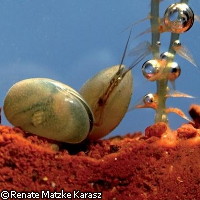Sperm make or break a male's victory
Bright plumage, pheromones and massive antlers are just some of the things male animals use to attract the opposite sex. But are they foolproof? No, says a team of international researchers who have found that rivals cannot claim a solid victory even after mating. The research, funded in part by the EU under the Marie Curie Research Training Networks (RTN) programme, shows that sperm, and their size in particular, play a more important role in the battle of fertilisation. The findings are published in the journal Science. The study was also an outcome of the EU-funded SEXASEX ('Sex to asex: a case study on transitions and coexistence between sexual and asexual reproduction') project, which was funded with EUR 2.2 million through the Sixth Framework Programme (FP6) under the 'Human resources and Mobility' Theme. Sperm become rivals: the bigger the sperm, the stronger the chance the male will succeed in fertilising the ova. Giant sperm cells have evolved in a number of species; in some cases, sperm, when unravelled, can even be bigger than the males that produce them. Led by Dr Renate Matzke-Karasz of Ludwig-Maximilians-Universität (LMU) München in Germany, the research team indirectly found signs of giant sperm in fossilised ostracods, members of the Crustacea that are sometimes called 'seed shrimp' or 'mussel shrimp'. They used synchrotron X-ray holotomography to look non-invasively deep inside these ancient, tiny crustaceans. 'Holotomography is a non-destructive imaging technique like computer tomography, where powerful and coherent synchrotron X-rays are used,' explained Dr Paul Tafforeau of the European Synchrotron Radiation Facility (ESRF), which developed the technique. 'With this method, a three-dimensional image of the inner structures - even of microscopically small objects - can be reproduced without doing any damage, with contrast and precision levels not reachable with any other techniques.' Team member Dr Giles Miller of the Natural History Museum in the UK said: 'We obtained an excellent image of the reproductive apparatus of the fossil ostracods and were in for a real surprise. Our results show that these 100-million-year-old Cretaceous ostracods were already reproducing with giant sperm.' According to Dr Matzke-Karasz, the team detected organs in the microfossils that are needed for transferring giant sperm. 'Since recent ostracods still produce giant sperm, and manoeuvre them with the same organs as 100 million years ago, it's safe to say that this distinctive feature evolved only once in this group,' she said. The team noted that the ostracods produce sperm that are up to 10 times as big as the animals themselves. According to the researchers, ostracods are popular in the fossil 'world', some dating back 450 million years, since despite being only a few millimetres long, they are surrounded by a bivalve-like calcareous shell which fossilises well. 'They are an important group in that their remains store information about the environment they lived in,' Dr Matzke-Karasz said. 'The fossilised shells of ostracods are therefore a kind of archive of Earth's history, storing information on climate, ecology and geology thousands, even millions, of years ago.' Most people recognise that the more sperm produced by a male, the more likely they will fertilise the ovum before other sperm do. However, for some species it's about quality, not quantity; it is easier for big sperm to trounce their smaller rivals. However, males expend more energy producing and carrying their bigger gametes. In another part of the study, researchers compared human sperm with the sperm of the fruit fly, Drosophila bifurca. According to them, proportionally, human sperm would have to be 40 metres long if it were to go up against the Drosophila's sperm. The males of this species reportedly have the longest sperm of any organism on Earth: a whopping 5.8 centimetres long when uncoiled. The project successfully pieces together a long-standing puzzle. 'Until now, it had been unknown whether giant ostracod sperm arose multiple times over the course of evolution, like those of Drosophila, or whether they have been a persistent feature in certain groups for millions of years,' Dr Matzke-Karasz underlined. 'This question can now be answered once and for all: giant sperm have been produced in at least some species over long periods of time, even though they come at an extremely high price for both males and females. The next stage of our research is to try to understand why and how it has persisted for so long.'
Countries
Germany

